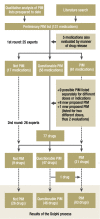Potentially inappropriate medications in the elderly: the PRISCUS list
- PMID: 20827352
- PMCID: PMC2933536
- DOI: 10.3238/arztebl.2010.0543
Potentially inappropriate medications in the elderly: the PRISCUS list
Abstract
Background: Certain drugs are classified as potentially inappropriate medications (PIM) for the elderly because they carry an increased risk of adverse drug events in this patient group. PIM lists from other countries are of limited usefulness in Germany because different drugs are on the market in each country and prescribing practices vary as well. Thus, a list of potentially inappropriate medications for the elderly was developed specifically for use in Germany.
Methods: A preliminary PIM list suitable for the German market was created on the basis of a selective literature search and a qualitative analysis of published international PIM lists. The final German PIM list was developed by means of a comprehensive, structured expert survey in two rounds (a so-called Delphi process).
Results: 83 drugs in a total of 18 drug classes were rated as potentially inappropriate for elderly patients. For 46 drugs, the experts came to no clear decision after the second Delphi round. For cases in which the administration of a PIM is clinically necessary, the final PRISCUS list contains recommendations for clinical practice, e.g. monitoring of laboratory values and dose adaptation. Therapeutic alternatives are also listed.
Conclusion: Potentially inappropriate medications carry the risk of causing adverse drug events in the elderly. A drawback of using a Delphi process to generate a PIM list, as was done for the new German list, is that little scientific evidence is currently available for the evaluation of active substances, potential therapeutic alternatives, and indicated monitoring procedures. Thus, the validity and practicability of the PRISCUS list remain to be demonstrated (and the same holds for PIM lists already published in other countries). It should be used as a component of an overall concept for geriatric pharmacotherapy in which polypharmacy and interacting medications are avoided, and doses are regularly re-evaluated.
Figures
Comment in
-
Correspondence (letter to the editor):Pain Therapy.Dtsch Arztebl Int. 2010 Dec;107(50):900; author reply 900–901. doi: 10.3238/arztebl.2010.0900a. Epub 2010 Dec 17. Dtsch Arztebl Int. 2010. PMID: 21246028 Free PMC article. No abstract available.
References
-
- Akker M vd, Buntinx F, Knottnerus A. Comorbidity or multimorbidity: what’s in a name? A review of the literature. Eur J Gen Pract. 1996;2:65–70.
-
- Coca V, Nink K. Arzneimittelverordnungen nach Alter und Geschlecht. In: Schwabe U, Paffrath D, editors. Arzneiverordnungsreport 2009. Heidelberg: Springer Medizin Verlag; 2009. pp. 901–914.
-
- Laroche ML, Charmes JP, Bouthier F, Merle L. Inappropriate medications in the elderly. Clin Pharmacol Ther. 2009;85:94–97. - PubMed
Publication types
MeSH terms
LinkOut - more resources
Full Text Sources
Medical


